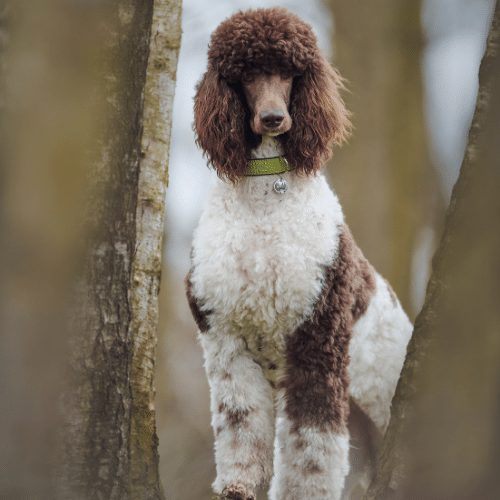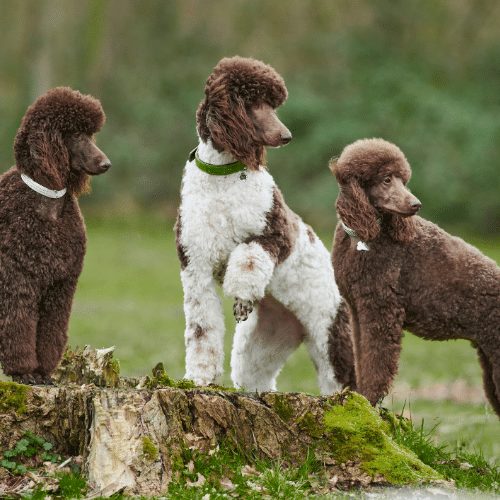When it comes to poodles, one might assume that they only come in a single solid color. However, did you know that poodles can actually have two different colors? That’s right! These intelligent and elegant dogs are known for their distinctive curly coats, and some poodles possess the unique trait of having two colors on their fur.
Poodles have a fascinating history that dates back centuries. Originally bred as water retrieving dogs, poodles were highly valued for their swimming abilities and their hypoallergenic coats. Over time, breeders developed different variations of poodles, including the standard, miniature, and toy sizes. Along with size variations, poodles can also display a range of colors, including black, white, brown, gray, apricot, and even multi-colored patterns. This diversity makes poodles a beloved and sought-after breed among dog enthusiasts worldwide.
Poodles can indeed be two colors! This is known as a parti-colored coat pattern. While poodles are commonly seen in solid colors, such as black, white, or apricot, parti-colored poodles have distinct patches of different colors. These patches can be any combination, offering a unique and eye-catching appearance. The parti-color pattern is recognized by breed standards, so if you’re looking for a poodle with two colors, this is a great option!

Poodle Coat Colors: Exploring the Possibilities
Poodles are known for their distinctive curly coats and elegant appearance. They come in a variety of solid colors, such as black, white, apricot, and silver. However, many people wonder if poodles can have more than one color in their coat. Can poodles be two colors? Let’s dive into the world of poodle coat genetics and find out!
When it comes to poodle coat colors, there are two main factors at play: genetics and breeding. Different genetic combinations and breeding practices can result in poodles with varying coat patterns and colors. While poodles can have multi-colored coats, it’s important to note that not all poodles will exhibit this trait. Let’s explore the possibilities!
Parti Poodles: The Multi-Colored Beauties
One of the most common ways poodles can have two colors in their coat is through the parti gene. Parti poodles have a primarily white base coat with patches or spots of another color. These patches can be any other recognized poodle color, such as black, brown, gray, apricot, or red. The parti gene is a recessive trait, meaning both parents must carry the gene for it to be expressed in their offspring.
Parti poodles are often sought after for their unique and eye-catching appearance. Their coat patterns can vary widely, from mostly white with a few splashes of color to a more evenly distributed mixture of white and another color. Parti poodles are recognized by breed clubs and can compete in poodle conformation shows as long as they meet the breed standard requirements.
Sable Poodles: A Dynamic Coloration
Another way poodles can display two colors in their coat is through the sable gene. Sable poodles have a base coat color that gradually fades or changes to another color at the tips. This creates a dynamic and ever-changing appearance, with the coat appearing lighter at the base and darker at the tips. Sable poodles can have a wide range of coat colors, including brown, silver, apricot, or red.
The sable gene can be quite fascinating to observe, as the coat can change drastically over time. A sable poodle puppy may be born with a solid base color and gradually develop a sable pattern as they mature. It’s important to note that not all poodles carry the sable gene, so this coloration is more rare compared to solid or parti-colored poodles.
Bicolor and Tricolor Poodles: A Splash of Variety
In addition to parti and sable poodles, it is also possible for poodles to exhibit bicolor or tricolor coat patterns. Bicolor poodles have a base coat of one color with distinct patches of another color, usually on their head, ears, chest, and legs. Tricolor poodles, on the other hand, have a base coat color with two additional distinct colors in specific areas of their body.
Bicolor and tricolor poodles can have a wide variety of color combinations. Some common examples include black and white, black and tan, or black, white, and tan. These coat patterns can occur naturally through genetic variations or as a result of selective breeding. Bicolor and tricolor poodles are also recognized by breed clubs and can compete in conformation shows.
Factors Influencing Coat Colors
The color and pattern of a poodle’s coat are influenced by various factors, including genetics, breeding practices, and the presence of specific pigment genes. The genes responsible for coat color in poodles are still being studied, and new discoveries are constantly being made. Breeders who specialize in producing multi-colored poodles carefully select parents with desirable coat traits to produce litters with specific coat patterns.
It’s important to note that coat color and patterns can also change over time. Poodle puppies are often born with a solid base color, and their coat may develop additional colors or patterns as they grow. This adds to the uniqueness and beauty of each poodle’s coat.
Conclusion: The Variety of Poodle Coat Colors
So, can poodles be two colors? The answer is yes! Poodles can have two colors in their coat due to various genetic factors, including the parti gene, sable gene, or through bicolor and tricolor coat patterns. These multi-colored poodles are unique and eye-catching, adding to the charm of the breed. Whether you prefer solid-colored, parti-colored, or multi-colored poodles, there is a perfect poodle out there for everyone!
Poodle Coat Colors Comparison
| Coat Type | Coloration | Description |
|---|---|---|
| Parti Poodle | Primarily white with patches or spots of another color | Distinctive multi-colored coat pattern |
| Sable Poodle | Base coat gradually fades or changes to another color at the tips | Dynamic and ever-changing appearance |
| Bicolor Poodle | Base coat of one color with distinct patches of another color | Two-color coat pattern |
| Tricolor Poodle | Base coat color with two additional distinct colors in specific areas | Three-color coat pattern |
Key Takeaways
- Yes, poodles can be two colors.
- Some poodles have a solid base color with markings of another color.
- These color combinations are recognized by breed standards.
- Common two-color combinations in poodles include black and white, apricot and white, and chocolate and white.
- The two-color pattern can be seen in the coat, particularly in the markings around the face, ears, and paws.
Frequently Asked Questions
Here are some commonly asked questions about poodles and their coat colors.
1. Are poodles only one color?
Poodles can actually come in a variety of colors. While most people are familiar with the classic solid colors of black, white, and apricot, poodles can also be found in multi-color and parti-color patterns. These patterns can include combinations of two or more colors, making poodles versatile and unique.
The multi-color and parti-color patterns can be quite striking, with colors blending or splicing together in various patterns. This adds to the charm and individuality of each poodle, making them even more special.
2. What are the different types of multi-color patterns in poodles?
There are several different types of multi-color patterns that can be found in poodles. One common pattern is the “phantom” pattern, where the dog has a solid base color with defined markings of a second color. The second color is usually found on the eyebrows, muzzle, chest, and legs.
Another multi-color pattern is the “brindle” pattern, where the base color is streaked or striped with a second color, creating a unique and beautiful effect. The intensity of the brindle pattern can vary, with some dogs having more pronounced stripes and others having a more subtle blending of colors.
3. Can poodles have a parti-color coat?
Yes, poodles can have a parti-color coat, which is characterized by large patches of different colors on the body. These patches can be evenly distributed or have a more random arrangement, giving each poodle a distinct and eye-catching appearance.
Parti-color poodles are often seen with a combination of white and another color, such as black, brown, or apricot. The contrast between the two colors creates a striking visual effect and makes them stand out from other poodles.
4. Are there any restrictions on poodle colors for show competitions?
In show competitions, poodle breed standards vary depending on the country and kennel clubs. Some kennel clubs only recognize solid colors, while others accept parti-colors and multi-colors as well. It’s important to check the specific breed standards for the poodle show competitions you are interested in participating in.
Regardless of the restrictions in show competitions, all poodle colors are equally loved and cherished as pets and companions. The unique coat colors and patterns only add to the charm and appeal of these intelligent and loving dogs.
5. Can poodles change their coat colors as they grow older?
While poodle puppies may appear one color at birth, their coat colors can sometimes change as they grow older. Some poodle puppies may start out with a lighter coat color and gradually darken as they mature. Other puppies may have more pronounced markings that may fade or become less defined as they age.
It’s important to note that coat color changes in poodles are natural and can vary from dog to dog. These changes do not affect the poodle’s health or temperament but simply add to their unique characteristics.

POODLE COLORS EXPLAINED| Do Poodles Fade?- The Truth| The Poodle Mom
In summary, poodles can come in a variety of colors, including two-color combinations.
While the standard poodle breed is typically one solid color, there are also poodles known as parti-poodles that have a coat with two or more colors. Therefore, it is indeed possible for poodles to be two colors.
